Blooming baby

An almost recession-proof category, the latest report on baby food by Euromonitor in Ireland, shows sales are projected to reach €97 million by 2021. And with one of the highest birth rates in Europe, sales of nappies and nappy accessories here are also the envy of other European countries, writes Gillian Hamill
15 March 2017
AT A GLANCE: INFANT AND BABY
- Baby food in Ireland has experienced current value growth of 2% in 2016, reaching sales of €91 million*
- The baby food market is said to be almost recession-proof, as illustrated by the period 2011 – 2016 in which the category grew by an average of 6% while all other food markets grew by 2%
- Euromonitor reports baby food is predicted to see a value CAGR of 1% at constant 2016 prices over the forecast period, with sales projected to reach €97 million by 2021*
- In Ireland, per capita volume of nappies among children aged 0-36 months is higher than the average usage in Western Europe, with 1,162 units per child in Ireland, versus 963 units per child across Western Europe**
- Despite the fact that the Irish birth rate is set to remain well above the Western Europe average, the country’s birth rate is still set to decline, with the proportion of the Irish population accounted for by children aged up to 36 months expected to decline from 6% in 2016 to 5% in 2021**
- Value sales of wipes are set to increase at a CAGR of 2% at constant 2016 prices***
- Inspired by 40 years of breastmilk research, Aptamil says its experts have developed Aptamil Profutura Follow On and Growing Up milks, with the brand’s most advanced formulas yet
- Award-winning Pip and Pear Chilled Baby Food launched in May 2015 and in short time the fast growing baby food brand has experienced considerable success
- 2016 saw the launch of Pip & Pear’s Toddler range which caters for the one to three years old age bracket
- The Caldesene range has expanded over recent years and now consists of Caldesene Powder, Caldease Ointment and CaldeSpray
- Bepanthen is the strong number two player in the nappy care category and the fastest- growing brand in the grocery market with +3% year-on-year growth (Source: Nielsen MAT Nov 2016)
*(Source: ‘Baby Food in Ireland’, published by Euromonitor in September 2016)
**(Source: ‘Nappies/Diapers/Pants in Ireland’, published by Euromonitor in March 2017)
***(Source: ‘Wipes in Ireland’, published by Euromonitor in March 2017)
 Ireland has one of the highest birth rates in Europe, according to Eurostat. As well as the long-term population impact, the short-term economic effect is that demand for baby and toddler product of all varieties remains strong.
Ireland has one of the highest birth rates in Europe, according to Eurostat. As well as the long-term population impact, the short-term economic effect is that demand for baby and toddler product of all varieties remains strong.
While the instinct among parents to provide the best for their infant is unmistakable, so also is the urgency for value for money and quality. With that in mind, there is strong competition among manufacturers to remain competitive while using the finest ingredients and materials.
The result is a wide range of choice for retailers and consumers. In fact, the baby food market is said to be almost recession-proof, as illustrated by the period 2011 – 2016 in which the category grew by an average of 6% while all other food markets grew by 2%.
Favourable demographics
A new report entitled ‘Baby Food in Ireland’, published by Euromonitor in September 2016, shows baby food here has experienced current value growth of 2% in 2016, reaching sales of €91 million. The rising unit price of baby food, facilitated by the general economic improvement within Ireland as a whole, has contributed to this growth, according to Euromonitor. As mentioned earlier, rates of childbirth in Ireland remain one of the highest in the EU, and the age demographics of mothers are also favourable towards the category – the average age of women giving birth in Ireland in 2016 was approximately 30 years. Older mothers, being in general more amenable to health and wellness trends, remain more predisposed to spending extra on baby food, which has again favoured the upward movement of unit prices. The tendency towards organic and more natural products continued in 2016.
Euromonitor subsequently reports baby food is predicted to see a value CAGR of 1% at constant 2016 prices over the forecast period, with sales projected to reach €97 million by 2021. However, the birth rate in Ireland is expected to continue falling over the forecast period, albeit at a slower rate. Economic growth, combined with increased consumer confidence and higher employment levels should help maintain unit prices. On the other hand, Euromonitor points out that time constraints and a growing housing crisis are likely to negatively influence childbirth levels, and thus hinder stronger growth within the category.
 Trend towards self-sufficiency
Trend towards self-sufficiency
While convenience is important within baby food, a recent report by Mintel also highlights the importance of using first-rate ingredients and delivering nutritious options with the same benefits as homemade fayre. In a UK report by Mintel entitled ‘Baby Food and Drink’, published in April 2016, Amy Price, senior food and drink analyst, states: “Homemade food continues to dominate usage, offering parents a cheaper way to feed their child as well as control over ingredients. This poses a threat to the baby food and drink market.”
However the trend towards self-sufficiency also presents a valuable opportunity that savvy brands can capitalise on. “Brands and own-labels can play a role in helping self-sufficiency, through sharing their expertise for example in online tutorials,” says Price. “This can position them as empowering parents but also offers a means for them to show how they can help offload some of this burden.”
Opportunities
Successful brands within the baby and infant sector are fully aware of the importance of shouting about their health credentials moreover. “Brands could offer parents more reassurance about the healthiness of manufactured baby/toddler food by referencing more actively on-pack all the nutritional qualities the product has to offer, acknowledging key nutrients such as protein, calcium and carbohydrates,” said Colette Warren, food and drink analyst for Mintel, in 2015.
Mintel’s 2015 report on the category also showed there is scope for baby/toddler snacks to extend usage past 36 months as quarter of parents think baby/toddler snacks are a good choice for older children. Positioning baby snacks as suitable for older children has the potential to give this segment a greater shopping basket share, according to Mintel, and will also help brands to overcome the short window of opportunity that manufactured baby foods typically face in terms of usage.
Nappies’ performance
 Another sector recently examined by Euromonitor meanwhile was that of nappies. Its report on ‘Nappies/Diapers/Pants in Ireland’ was published just this month. It shows that in this country, per capita volume of nappies among children aged 0-36 months is higher than the average usage in Western Europe, with 1,162 units per child in Ireland, versus 963 units per child across Western Europe. This is in line with most Northern European countries, where potty training is usually conducted later than in Southern European countries. Indeed, according to Euromonitor, northern countries share the custom of respecting the child’s own preferences with regards to timing the start of using the potty, and this is usually at the age of two to two-and-a-half years old, while in southern countries, parents usually take the initiative in terms of starting potty training at around 18 months or two years of age.
Another sector recently examined by Euromonitor meanwhile was that of nappies. Its report on ‘Nappies/Diapers/Pants in Ireland’ was published just this month. It shows that in this country, per capita volume of nappies among children aged 0-36 months is higher than the average usage in Western Europe, with 1,162 units per child in Ireland, versus 963 units per child across Western Europe. This is in line with most Northern European countries, where potty training is usually conducted later than in Southern European countries. Indeed, according to Euromonitor, northern countries share the custom of respecting the child’s own preferences with regards to timing the start of using the potty, and this is usually at the age of two to two-and-a-half years old, while in southern countries, parents usually take the initiative in terms of starting potty training at around 18 months or two years of age.
Euromonitor reports that the positive growth projections for nappies/diapers/pants over the forecast period reflect the high levels of saturation which have already been reached in the category. Nevertheless, demand for these products is set to be maintained by high levels of promotional activity in discounters and online stores. In addition, despite the fact that the Irish birth rate is set to remain well above the Western Europe average, the country’s birth rate is still set to decline over the forecast period and the proportion of the Irish population accounted for by children aged up to 36 months is expected to decline from 6% in 2016 to 5% in 2021.
Wiping up
Euromonitor also published a report earlier this month on ‘Wipes in Ireland’. This shows 2016 saw value sales of wipes undermined by falling unit prices, which was in turn induced by the strong emergence of private label within the category and the general preference of consumers for products which offer higher levels of convenience. Nevertheless, thanks to the recovery of the Irish economy, the static current value growth recorded in wipes in 2016 represented an improvement on previous years. According to Euromonitor, spreading environmental concerns also contributed to the maintenance of value sales of wipes during the year. Irish consumers are going ‘green’ and consumers are thus tending to switch to more environmental friendly alternatives to both personal wipes and home care wipes.
According to Euromonitor, the performance expected in wipes over the forecast period is set to be much stronger than the negative growth recorded in the category over the review period, with value sales set to increase at a CAGR of 2% at constant 2016 prices. This improvement in the category’s performance is set to be mainly due to the slow increases being seen in the average unit price of wipes. With the support of rising demand, manufacturers are expected to slowly reduce their reliance on price competition in order to improve their revenues.
Most advanced formulas yet
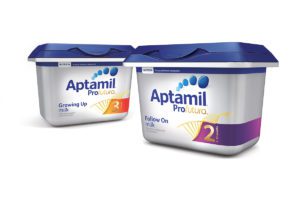
Aptamil Profutura Follow On and Growing Up milks contain a unique blend of ingredients including the brand’s highest ever levels of DHA (Omega 3 LCP)
Inspired by 40 years of breastmilk research, Aptamil’s experts have developed Aptamil Profutura Follow On and Growing Up milks, the brand’s most advanced formulas yet. They contain specific nutrients tailored to complement a baby’s diet in order to support them as they undergo significant growth and cognitive development. Aptamil Profutura Follow On and Growing Up milks contain a unique blend of ingredients including the brand’s highest ever levels of DHA (Omega 3 LCP)* which supports normal visual development. Aptamil Profutura Follow On and Growing Up milk also contain sources of calcium and vitamin D which support normal growth and development of bone.
Aptamil Profutura Follow On and Growing Up milks are now available in the brand’s most innovative pack ever, the Smart Pack. The 800g Smart Pack features a tamper-proof lid for added security, a built in leveller on both the left and right hand side, making scooping easier, an underlid scoop storage as well as a scoop rest for storing the scoop between use for improved hygiene.
*(Aptamil Profutura Follow On milk contains 33% more DHA (Omega 3 LCP) than in all Aptamil Follow On milks. Aptamil Profutura Growing Up milk contains 35% more DHA (Omega 3 LCP) than in all Aptamil Growing Up milks).
(Aptamil provides the following important notice: Breastfeeding is best for babies. Aptamil Profutura Follow On milk is only for babies aged six months and over as part of a varied weaning diet and should not be used as a breastmilk substitute before six months. All formula milks should be used on the advice of a healthcare professional. Aptamil Profutura Growing Up milk should be used as part of a healthy, balanced diet.)
All the goodness; none of the guilt
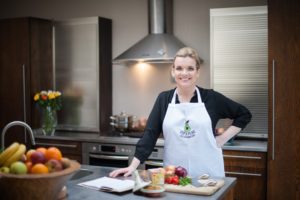
Mother of two and restaurateur, Irene Queally founded the Pip & Pear range
Award-winning Pip & Pear Chilled Baby Food launched in May 2015 and in short time the fast-growing baby food brand has experienced considerable success.
The Irish-made range is gently cooked using 100% Irish Bord Bia approved meat and poultry and certified organic fruit and vegetables. Each pot of Pip & Pear contains up to two of baby’s five a day and contains no added salt, sugar or additives, ensuring all of the goodness for baby and none of the guilt for time-pressed parents.
Founded by Irene Queally, mother of two and restaurateur, she saw a demand for a baby food range that was just like homemade, nutritious, tasty and filled with vibrant flavours and textures. Quality is key to the brand and the large collection of awards received to date is a true testament of this.
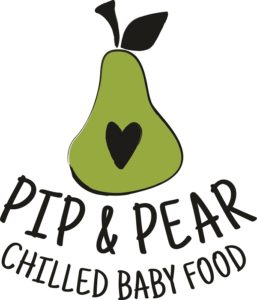
The Pip & Pear range uses 100% Irish Bord Bia approved meat and poultry and certified organic fruit and vegetables
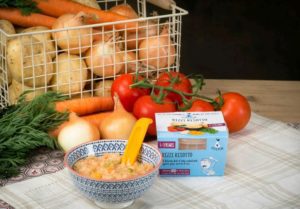
Pip & Pear was established after its founder food Irene Queally saw a gap in the market for a range that was just like homemade food, nutritious, tasty and filled with vibrant flavours and textures
2016 saw the launch of Pip & Pear’s Toddler Range which caters for the one to three years old age bracket. This new product development is a result of increased feedback from parents who continue to seek an alternative to homemade meals for their older babies and toddlers. These nutritious meals contain larger chunks and are perfectly portioned for this age group.
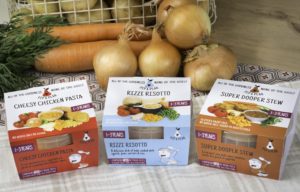
Last year saw the launch of Pip & Pear’s Toddler Range which caters for the one to three years old age bracket
In its most recent report, Euromonitor declared the advantage of the Pip & Pear range, stating the appeal of the shorter shelflife to health-conscious parents and the more natural characteristics of its food. The nutritional quality of baby food is paramount for parents and consumers are now looking for foods which contain no added salt, sugar or additives and made by a brand they can trust. (Source: Baby Food in Ireland, Euromonitor International September 2016)
Pip & Pear is now stocked in Aldi nationwide and selected SuperValu stores and is merchandised in the dairy fridge. 2017 will see further expansion in the Irish and export market along with additional product launches.
An ideal choice for busy parents
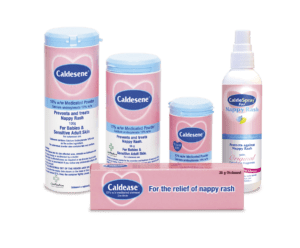
Caldesene works by attacking harmful bacteria and soothing skin irritation
The Caldesene range has seen great expansion over recent years and now consists of Caldesene Powder, Caldease Ointment and CaldeSpray.
Caldesene Powder is a medicated baby powder that prevents and treats nappy rash. It works by attacking harmful bacteria and soothing skin irritation. Its special formulation also means that it forms a barrier against wetness on your baby’s skin. Caldesene Powder is available in three handy sizes, 20g, 55g and 100g.
CaldeSpray 100ml is a zinc oxide milk spray for nappy rash. This concentrated spray has excellent skin adherent and skin protective properties which form a protective barrier against wetness. There are approximately 250 changes in each bottle of CaldeSpray. CaldeSpray is an ideal choice for busy mums and dads on-the-go, as it offers several advantages.
Firstly, easy application. CaldeSpray couldn’t be easier to use; simply shake well and apply one to two sprays to the baby at each nappy change to protect against nappy rash. There is also no need to rub; just spray and go; with CaldeSpray there is no mess and no sticky fingers – guaranteed! There is also no direct contact with skin. This eliminates the danger of infection and cross-contamination, and means there is no need to irritate the baby’s delicate skin. Parents subsequently don’t have to worry about further irritating the affected area or causing baby any pain or distress as the skin does not need to be touched.
Why does nappy rash occur?
When a baby wets a nappy, bacteria react with the urine on the nappy to form ammonia. If the nappy isn’t changed quickly, the ammonia can “burn” the baby’s delicate skin. If a nappy is wet and soiled at the same time, this causes a different chemical reaction which can irritate and damage the skin even more.
(CaldeSpray contains zinc oxide 10% w/w. Caldesene Medicated Powder contains calcium undecylenate 10% w/w. Always read the label).
Winner of two awards voted by mums
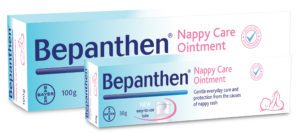
Bepanthen is the strong number two player in the nappy care category
Bepanthen is the strong number two player in the nappy care category and the fastest-growing brand in the grocery market with +3% year-on-year growth (source : Nielsen MAT Nov 2016).
The Bepenthen range provides parents and babies with gentle products that are developed specifically to care for and protect delicate skin every day. The Bepanthen brand is positioned around the ‘new generation of protection’.
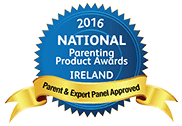
Winning the National Parenting Product awards and the Maternity & Infant award in 2016 confirms Bepanthen’s increasing popularity with new mums
In 2017, the company is investing heavily behind the brand with the aim of increasing its impact and presence and expanding its community of ‘brand advocates’. This includes an integrated campaign across Pregnancy TV, digital and social media outlets, pregnancy press as well as heavy sampling to pregnant women, mums and healthcare professionals.
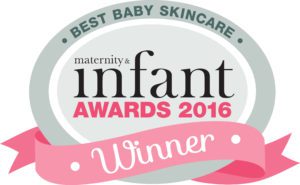 Bepanthen’s key message, ‘Why wait for nappy rash to appear?’ will be communicated through digital display and video testimonials from Irish mums who are advocates of the brand and through an experienced clinical midwife manager. According to Marion Rogan, manager of the category at Bayer: “Bepanthen is gaining real momentum and winning the National Parenting Product awards and the Maternity & Infant award in 2016 confirms its increasing popularity with new mums.”
Bepanthen’s key message, ‘Why wait for nappy rash to appear?’ will be communicated through digital display and video testimonials from Irish mums who are advocates of the brand and through an experienced clinical midwife manager. According to Marion Rogan, manager of the category at Bayer: “Bepanthen is gaining real momentum and winning the National Parenting Product awards and the Maternity & Infant award in 2016 confirms its increasing popularity with new mums.”
Attendance at the Pregnancy & Baby Fair is also an important part of the plan for Bepanthen and is a great opportunity for the team to meet pregnant women who are starting on their new journey.
Bepanthen will also participate in added value promotional activity in-store.



 Print
Print
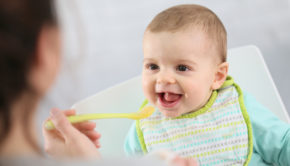



Fans 0
Followers